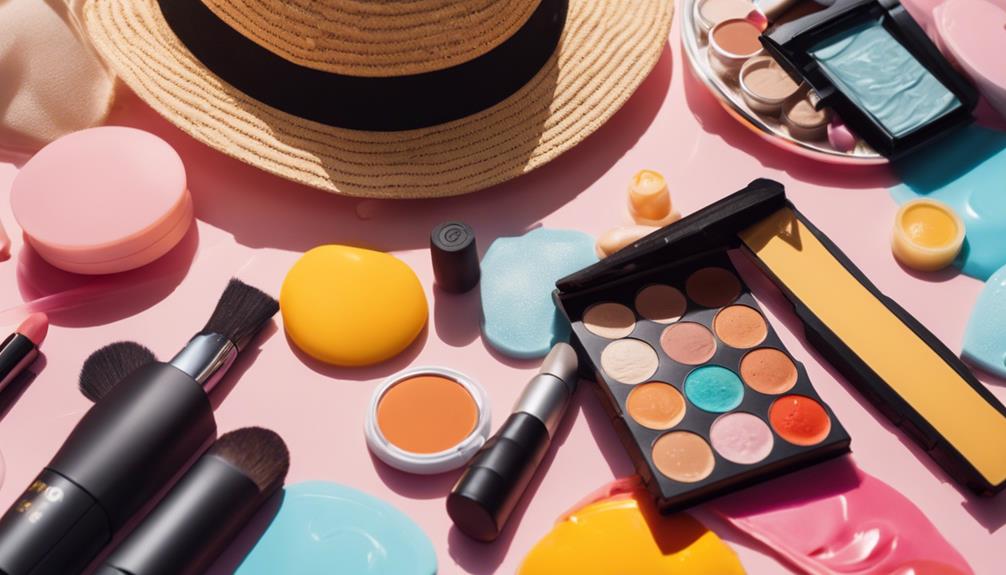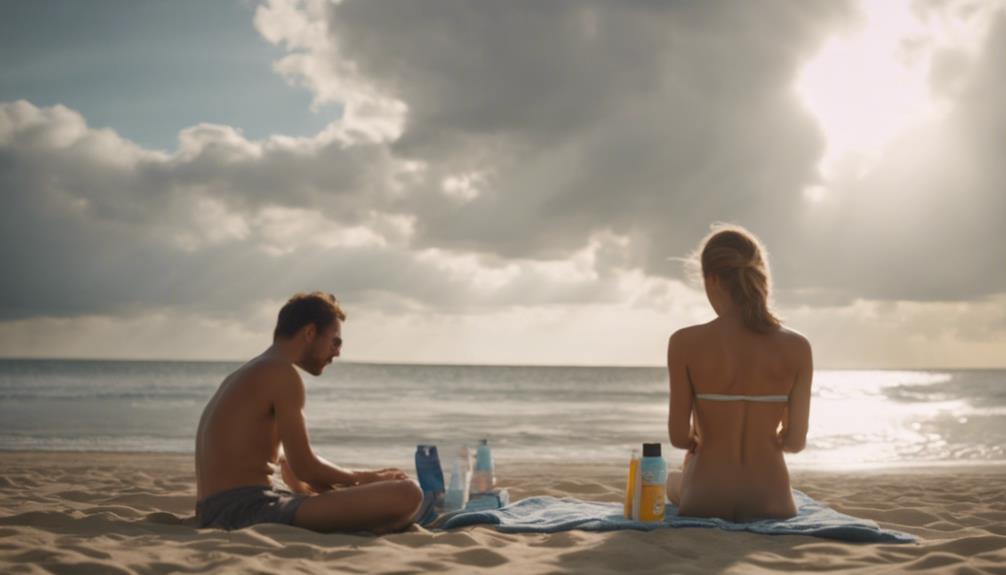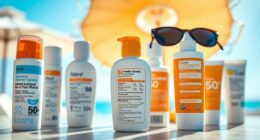Makeup with SPF can offer some protection against UV rays, but it's usually not enough to replace dedicated sunscreen. Most makeup products contain SPF ratings between 15 and 30, which may not provide adequate coverage. To protect your skin effectively, apply a broad-spectrum sunscreen with at least SPF 30 first, then layer your makeup on top. Remember, reapplying sunscreen every two hours is vital for maintaining protection, even with SPF makeup. To get the most out of your sun protection routine, check out tips on combining products for best results.
Key Takeaways
- Makeup with SPF often provides lower protection levels, typically between SPF 15 and SPF 30, which may not be sufficient for full sun defense.
- SPF in makeup should supplement, not replace, dedicated sunscreen with at least SPF 30 for optimal protection against UV rays.
- Adequate application amounts are crucial; achieving labeled SPF levels requires using 6-7 times more makeup than typically applied.
- Reapplication of sunscreen every two hours is necessary, even with SPF makeup, to maintain effective sun protection throughout the day.
Importance of Sunscreen
When it comes to protecting your skin, sunscreen is a must-have to guard against the harmful effects of UV rays. These rays are the leading cause of skin cancer and can accelerate premature aging.
To guarantee effective sun protection, you should choose a sunscreen with a minimum SPF of 30, which blocks about 97% of UVB rays. Applying sunscreen generously is key—think about a nickel-sized amount for your face.
Reapplication is essential too; every two hours, or more often if you're swimming or sweating, is ideal.
Regular use of sunscreen not only reduces the risk of skin cancer but also helps prevent long-term skin damage, such as wrinkles and sunspots.
Types of SPF Products

Understanding the different types of SPF products is essential for choosing the right protection for your skin. When incorporating SPF in makeup into your daily routine, you'll encounter various formulations designed to shield your skin from harmful UVB rays and other sun damage.
Here are some key types of SPF products to take into account:
- Chemical Sunscreens: These absorb UV rays and are often lightweight, making them suitable for daily wear.
- Mineral Sunscreens: These physical (mineral) options reflect UV rays and are great for sensitive skin types.
- Broad-Spectrum SPF: Look for products that protect against both UVA and UVB rays for thorough defense.
- Tinted SPF Products: These offer sun protection along with light coverage, evening out your skin tone seamlessly.
Application Guidelines

To get the most out of your SPF products, follow specific application guidelines that guarantee effective sun protection while wearing makeup. Start by applying sunscreen as the last step in your skincare routine, ideally 15-30 minutes before makeup. Use a broad-spectrum sunscreen with at least SPF 30, applying a nickel-sized dollop for proper protection. Allow it to dry completely before layering your makeup to maximize benefits.
Here's a quick reference table to help you:
| Step | Action | Notes |
|---|---|---|
| 1. Apply Sunscreen | Apply generously | Use a nickel-sized amount |
| 2. Wait | Allow to dry for 15-30 minutes | Guarantees ideal absorption |
| 3. Makeup Application | Apply makeup over dried sunscreen | SPF in your makeup supplements |
| 4. Reapply Sunscreen | Every 2 hours | Use mineral powder or setting spray |
Makeup Compatibility

When it comes to makeup with SPF, layering products effectively is key to maximizing protection.
You'll want to choose compatible formulations to avoid issues like pilling or separation, ensuring a smooth finish.
Plus, simplifying your reapplication techniques can help you maintain that sun defense throughout the day.
Layering Products Effectively
Layering your makeup products effectively starts with applying sunscreen first to provide maximum protection and a smooth base for your other products. Always choose a broad-spectrum sunscreen with at least SPF 30 and allow it to absorb before layering on your makeup. This guarantees that you're not compromising sun protection while achieving your desired look.
Here are some tips to help you layer products effectively:
- Use a nickel-sized amount of sunscreen for sufficient coverage on your face.
- Opt for lightweight makeup products like tinted moisturizers or foundations specifically designed to work over sunscreen.
- Avoid pilling by letting your sunscreen fully absorb before applying any makeup.
- Keep a mineral powder sunscreen handy for midday touch-ups without disturbing your makeup.
Choosing Compatible Formulations
Choosing makeup formulations that work well together is vital for achieving a flawless look while guaranteeing adequate sun protection.
When selecting makeup with SPF, look for products labeled as 'broad-spectrum' to protect against both UVA and UVB rays, with a minimum SPF of 30 for ideal UV protection. If you have oily or acne-prone skin, opt for non-comedogenic formulations to prevent clogged pores while still benefiting from sun protection.
Layering SPF-infused makeup over a dedicated sunscreen can greatly enhance your overall sun protection. However, it's important to test combinations of skincare and makeup products to avoid issues like pilling or separation. You want to make sure that your products are compatible formulations, so they work harmoniously together.
Mineral makeup products, such as tinted powders or foundations containing zinc oxide or titanium dioxide, are often more suitable for sensitive skin types and can be reapplied throughout the day without disturbing your makeup.
Reapplication Techniques Simplified
Reapplying sunscreen while wearing makeup can be straightforward if you use the right techniques and products tailored for compatibility. Keeping your skin protected from UV rays doesn't have to disrupt your makeup routine. Here are some effective reapplication methods:
Mineral Powder Sunscreens: These are lightweight and can be dusted over makeup without altering its appearance.
SPF-Infused Setting Sprays: These sprays refresh your makeup while providing an additional layer of skin protection.
Layering Techniques: Apply a broad-spectrum sunscreen underneath your makeup, then use SPF-infused powders or sprays on top for enhanced protection.
Timing is Key: Remember to reapply every two hours to maintain effective SPF coverage, even with makeup on.
Sufficient Amounts: Guarantee you're using enough product; most people underapply sunscreen, reducing effectiveness.
Myths About SPF Makeup

You might think that makeup with SPF is enough to protect your skin from UV rays, but that's not the case.
Many people underestimate how much product they need to apply for proper coverage, and they often forget about the need for reapplication throughout the day.
Let's clear up some of the common myths surrounding SPF in makeup so you can make informed choices for your skin.
Misunderstanding SPF Levels
Many people mistakenly believe that makeup with SPF provides sufficient sun protection, when in reality, it often falls short compared to dedicated sunscreens. While it's tempting to rely solely on your makeup for protection from harmful UV rays, you need to be cautious.
Here are some critical points to take into account:
- Makeup typically has lower SPF ratings (often SPF 15 to SPF 30) than standalone sunscreens.
- In order to receive the SPF protection claimed on makeup labels, you'd need to apply an impractically large amount—6 to 7 times more than usual.
- Not all makeup meets the FDA's criteria for sunscreen, meaning some may not provide adequate protection.
- SPF in makeup should be viewed as a supplement, not a substitute for dedicated sunscreen.
Understanding these misconceptions can help you make informed choices about your sun protection routine.
For ideal defense against harmful UV rays, always layer your makeup over a dedicated sunscreen to guarantee your skin stays protected throughout the day.
Reapplication Requirements
Sunscreen needs regular reapplication, and relying solely on SPF makeup often leads to inadequate sun protection throughout the day. While makeup with SPF can offer some level of protection, it's vital to understand that most people don't apply enough product to achieve the labeled SPF ratings. To match the effectiveness of traditional sunscreen, you'd need to use six to seven times more makeup than you typically would.
Additionally, even if your makeup contains SPF, you still need to reapply every two hours for best effectiveness. This can be challenging, especially when wearing makeup. Most SPF-infused products tend to have lower SPF ratings, often between SPF 15 and SPF 30, which may not provide sufficient protection during extended sun exposure.
Keep in mind that the FDA has strict criteria for labeling products as sunscreen, meaning that makeup with SPF mightn't meet the same standards as dedicated sunscreen products. So, for solid sun protection, consider using a separate sunscreen product alongside your makeup routine. Prioritizing sun protection is essential to keep your skin safe and healthy.
Coverage Limitations
Despite the allure of convenience, relying on makeup with SPF can lead to misconceptions about its true effectiveness in providing adequate sun protection. While these products may offer some level of protection, they often fall short in several key areas.
Most makeup with SPF typically has lower ratings (SPF 15 to SPF 30) compared to dedicated sunscreens.
You'll need to apply considerably more product—around 6-7 times the usual amount—to achieve the SPF protection advertised.
SPF in makeup should only be viewed as supplementary; a dedicated sunscreen with at least SPF 30 is necessary for effective protection.
Many makeup formulations lack broad-spectrum protection against both UVA and UVB rays, essential for thorough defense against UV radiation.
Don't forget to reapply! Makeup with SPF generally needs reapplication every two hours to maintain adequate sun protection.
Understanding SPF Ratings

Understanding SPF ratings is essential for ensuring you get the sun protection you need when using makeup products. SPF, or Sun Protection Factor, indicates how much UVB radiation is blocked. For example, SPF 15 blocks about 93% of UVB rays, while SPF 30 blocks approximately 97%.
However, the SPF in makeup products often delivers less effective protection than standalone sunscreens. That's because most people don't apply enough makeup to achieve the full SPF benefits. Typically, makeup products with SPF range from SPF 15 to SPF 30, which means they may not provide adequate defense against sun damage on their own.
To fully protect your skin, you'd need to apply around 2 milligrams of product per square centimeter—far more than you'd usually use when applying foundation or powder.
For effective sun protection, consider using a dedicated sunscreen with at least SPF 30 underneath your makeup. This way, you're not relying solely on your makeup's SPF for protecting your skin. Instead, view the SPF in makeup as a supplementary layer, adding a bit of extra protection to your routine.
Effectiveness of SPF in Makeup

The effectiveness of SPF in makeup often falls short of providing adequate sun protection, primarily due to the lower SPF ratings and the amount typically applied. Most makeup products contain SPF ratings between 15 to 30, which aren't enough to fully protect your skin from harmful UV rays. To achieve the SPF protection indicated, you'd need to apply about 6-7 times the typical amount of foundation, which can be impractical.
Here are some key points to take into account:
- SPF ratings in makeup are generally lower than those in dedicated sunscreens.
- It's essential to apply sunscreen underneath your makeup for proper protection.
- Environmental factors like sweat and water can diminish the effectiveness of makeup formulas.
- Look for products labeled as broad-spectrum to guard against both UVA and UVB rays.
Reapplication Strategies

To maintain effective sun protection while wearing makeup, you need to plan for regular reapplications throughout the day. It's crucial to reapply sunscreen every two hours, even if your makeup contains SPF.
Remember, the SPF in makeup usually requires a much larger amount—about six to seven times more—to match the effectiveness of standalone sunscreen.
For convenient reapplication, consider using mineral powder sunscreens or setting sprays with SPF. These options allow you to protect your skin without disturbing your existing makeup layers.
When applying sunscreen, make sure you use a sufficient amount, roughly a quarter-sized dollop, to achieve adequate coverage.
Avoid touching up your makeup with foundation; instead, use products specifically designed for reapplication. They offer a lighter texture and are formulated to work well over makeup.
Recommended SPF Products

When choosing SPF products, look for options that combine effective sun protection with seamless application for your makeup routine. Incorporating SPF into your skin care can be easy with the right products. Aim for broad-spectrum formulas with at least SPF 30 to guarantee you're well protected.
Here are some recommended products to take into account:
- Laura Mercier Tinted Moisturizer SPF 30: This option hydrates while providing essential sun protection.
- EltaMD UV Elements Broad-Spectrum SPF 44: A higher SPF tinted sunscreen that blends well with various skin tones for daily wear.
- Colorescience Sunforgettable SPF 50: A mineral sunscreen powder that's perfect for on-the-go reapplications without disturbing your makeup.
- First Aid Beauty Ultra Repair Tinted Moisturizer SPF 30: Offers hydration and SPF in one easy step, making it a great multitasker.
Comprehensive Protection Tips

Always apply a dedicated sunscreen before your makeup to guarantee ideal protection against harmful UV rays. Look for a broad-spectrum sunscreen with at least SPF 30 to make sure you're adequately protected.
While makeup with SPF offers an extra layer of defense, it shouldn't replace your sunscreen. Most people don't apply enough foundation to match the SPF claims, so relying solely on makeup isn't enough.
Reapply your sunscreen every two hours, even when wearing makeup. Consider using mineral powder sunscreens or setting sprays with SPF for easy touch-ups throughout the day. These options won't disturb your makeup and help maintain effective protection against UV rays.
When selecting makeup, choose products labeled as ‘broad-spectrum' to protect against both UVA and UVB rays, which contribute to skin damage and aging. Remember, a combination of dedicated sunscreen and makeup with SPF provides the best overall protection.
Frequently Asked Questions
Does Makeup With SPF Really Work?
You might wonder if makeup with SPF really works. It can offer some protection, but it's not enough on its own. Always use a dedicated sunscreen underneath for effective UV defense and reapply regularly.
Is SPF Still Effective Under Makeup?
You might think wearing SPF under your makeup turns you into a sunblock superhero, but alas! It's not that simple. SPF needs ample application for real protection, so don't ditch the sunscreen just yet!
Do I Still Need Sunscreen if My Foundation Has Spf?
Yes, you still need sunscreen even if your foundation has SPF. Makeup usually doesn't provide enough coverage, and using a broad-spectrum sunscreen underneath guarantees you're adequately protected from harmful UV rays throughout the day.
Does Over Makeup SPF Work?
Over makeup SPF can offer some protection, but it usually isn't enough. You should apply a dedicated sunscreen first, and remember to reapply every two hours for effective sun defense throughout the day.
Can Sun Protection Routine Replace Makeup with SPF?
Looking for the best sun protection routine that could replace makeup with SPF? While a good sun protection routine is crucial, it’s advised to use a dedicated sunscreen with SPF in addition to makeup. Both offer different levels of protection, so combining them provides the best defense against UV rays.
Conclusion
In short, makeup with SPF can be a great addition to your skincare routine, but it shouldn't be your only line of defense against the sun.
While it offers some protection, you shouldn't put all your eggs in one basket; applying a dedicated sunscreen is still essential.
Remember to reapply regularly, especially if you're spending time outdoors.
By combining makeup and sunscreen, you're truly covering all your bases for healthy, protected skin.









